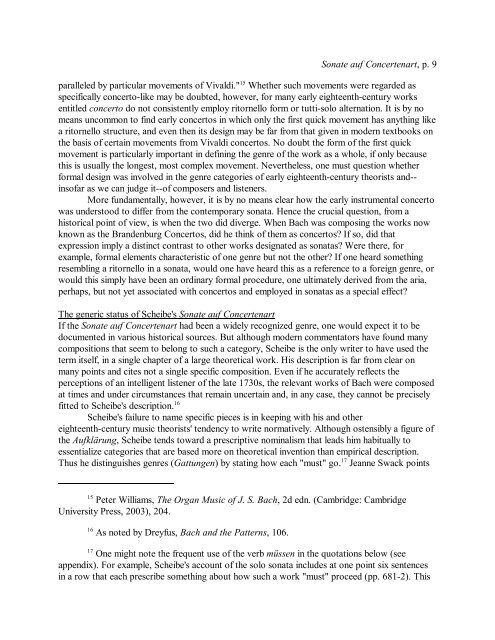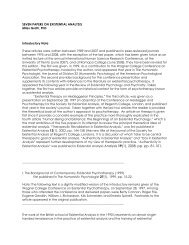The Sonate auf Concertenart: A Postmodern Invention? David ...
The Sonate auf Concertenart: A Postmodern Invention? David ...
The Sonate auf Concertenart: A Postmodern Invention? David ...
You also want an ePaper? Increase the reach of your titles
YUMPU automatically turns print PDFs into web optimized ePapers that Google loves.
<strong>Sonate</strong> <strong>auf</strong> <strong>Concertenart</strong>, p. 9<br />
15<br />
paralleled by particular movements of Vivaldi." Whether such movements were regarded as<br />
specifically concerto-like may be doubted, however, for many early eighteenth-century works<br />
entitled concerto do not consistently employ ritornello form or tutti-solo alternation. It is by no<br />
means uncommon to find early concertos in which only the first quick movement has anything like<br />
a ritornello structure, and even then its design may be far from that given in modern textbooks on<br />
the basis of certain movements from Vivaldi concertos. No doubt the form of the first quick<br />
movement is particularly important in defining the genre of the work as a whole, if only because<br />
this is usually the longest, most complex movement. Nevertheless, one must question whether<br />
formal design was involved in the genre categories of early eighteenth-century theorists andinsofar<br />
as we can judge it--of composers and listeners.<br />
More fundamentally, however, it is by no means clear how the early instrumental concerto<br />
was understood to differ from the contemporary sonata. Hence the crucial question, from a<br />
historical point of view, is when the two did diverge. When Bach was composing the works now<br />
known as the Brandenburg Concertos, did he think of them as concertos? If so, did that<br />
expression imply a distinct contrast to other works designated as sonatas? Were there, for<br />
example, formal elements characteristic of one genre but not the other? If one heard something<br />
resembling a ritornello in a sonata, would one have heard this as a reference to a foreign genre, or<br />
would this simply have been an ordinary formal procedure, one ultimately derived from the aria,<br />
perhaps, but not yet associated with concertos and employed in sonatas as a special effect?<br />
<strong>The</strong> generic status of Scheibe's <strong>Sonate</strong> <strong>auf</strong> <strong>Concertenart</strong><br />
If the <strong>Sonate</strong> <strong>auf</strong> <strong>Concertenart</strong> had been a widely recognized genre, one would expect it to be<br />
documented in various historical sources. But although modern commentators have found many<br />
compositions that seem to belong to such a category, Scheibe is the only writer to have used the<br />
term itself, in a single chapter of a large theoretical work. His description is far from clear on<br />
many points and cites not a single specific composition. Even if he accurately reflects the<br />
perceptions of an intelligent listener of the late 1730s, the relevant works of Bach were composed<br />
at times and under circumstances that remain uncertain and, in any case, they cannot be precisely<br />
fitted to Scheibe's description. 16<br />
Scheibe's failure to name specific pieces is in keeping with his and other<br />
eighteenth-century music theorists' tendency to write normatively. Although ostensibly a figure of<br />
the Aufklärung, Scheibe tends toward a prescriptive nominalism that leads him habitually to<br />
essentialize categories that are based more on theoretical invention than empirical description.<br />
17<br />
Thus he distinguishes genres (Gattungen) by stating how each "must" go. Jeanne Swack points<br />
15<br />
Peter Williams, <strong>The</strong> Organ Music of J. S. Bach, 2d edn. (Cambridge: Cambridge<br />
University Press, 2003), 204.<br />
16<br />
As noted by Dreyfus, Bach and the Patterns, 106.<br />
17 One might note the frequent use of the verb müssen in the quotations below (see<br />
appendix). For example, Scheibe's account of the solo sonata includes at one point six sentences<br />
in a row that each prescribe something about how such a work "must" proceed (pp. 681-2). This















